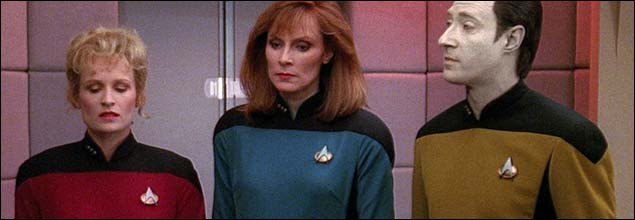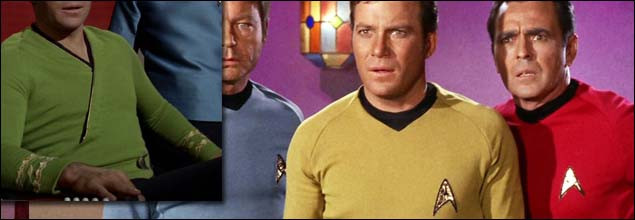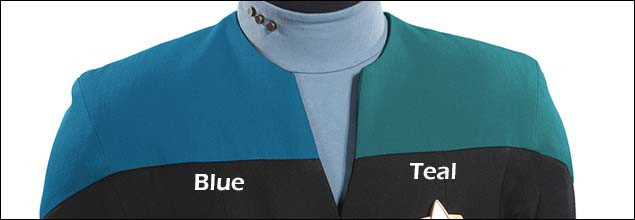In the Star Trek universe, particularly within Starfleet, Uniform Colors are more than just aesthetic choices. They serve as a visual shorthand, immediately indicating a crew member’s primary division and area of expertise. While the specific uniform styles evolved across different series, the core color-coding system remained a consistent element, helping viewers and in-universe personnel alike quickly understand the roles of those around them. This guide focuses on the uniform color system as seen in Star Trek: Voyager and the The Next Generation era, offering insights into what each color represents within Starfleet.
The uniforms prominently featured in Star Trek: Voyager are known as the Standard Duty Uniforms (SDU), introduced in 2369, just before Voyager’s journey into the Delta Quadrant. These uniforms, and others from the TNG era, utilize a distinct color system to denote divisional assignments within Starfleet. There are three primary division colors that are consistently used:
- Red: Command and Operations. This color signifies leadership roles, including Captains and other commanding officers, as well as crucial operational roles like pilots and security personnel.
- Gold (Yellow): Operations, Engineering, and Security. While sometimes appearing gold and other times yellow depending on lighting and production era, this color designates engineering, security, and operations divisions – those responsible for keeping the ship running and maintaining order.
- Blue: Sciences and Medical. Blue uniforms are worn by individuals in the science and medical divisions, encompassing fields from astrophysics to xenobiology and the ship’s medical staff.
 Commander Chakotay in his Science blue uniform.
Commander Chakotay in his Science blue uniform.
Note: The Sciences division color is officially a deep sapphire blue. However, variations in dye and lighting can sometimes make it appear as a teal or even slightly green shade, leading to occasional confusion for viewers.
Beyond Primary Roles: Dual Capabilities within Starfleet
It’s important to understand that while uniform color indicates a person’s primary divisional assignment, it doesn’t limit their capabilities or expertise to just that area. In Starfleet, officers often possess diverse skill sets and may perform duties outside their primary role, especially in situations requiring versatility or when personnel are limited. The uniform color simply reflects the division to which an individual is officially assigned based on their core responsibilities.
For example, a technician specialized in computer systems might be assigned to the Sciences division and wear a blue uniform, even if their daily tasks often involve working alongside the Engineering division. Their primary role is within Sciences, hence the blue uniform, despite their practical contributions to engineering functions.
On Voyager, this concept of dual roles becomes particularly relevant due to the crew’s isolation and limited numbers. Individuals frequently need to “wear multiple hats” to ensure the ship’s smooth operation. Tom Paris, for instance, is the ship’s helmsman and wears a red Operations uniform. However, he also possesses considerable expertise in areas like aerodynamics and warp field theory, fields typically associated with the Sciences or Engineering divisions. Similarly, Captain Kathryn Janeway, in her red Command uniform, is primarily a leader, but her background is deeply rooted in scientific disciplines, particularly physics. Before commanding the USS Billings as Executive Officer, she served as a Science Officer, highlighting her extensive scientific background despite her command role.
Historical Uniform Color Variations and Alternate Realities
It’s worth noting that the association of uniform colors with divisions has not been entirely consistent throughout Starfleet history, or even across all realities within the Star Trek multiverse. In Star Trek: The Original Series (TOS), the colors for Command and Operations were actually reversed compared to the TNG era. In TOS, command personnel wore gold (or yellow), while operations and engineering wore red. Furthermore, Captain Kirk’s uniform in TOS sometimes appeared as a unique light green tunic with gold trimmings, further differentiating command roles visually.
 Captain Kirk wearing the command gold/green tunic variant from Star Trek: The Original Series.
Captain Kirk wearing the command gold/green tunic variant from Star Trek: The Original Series.
Additionally, alternate timelines and realities within Star Trek often present variations in uniform colors, sometimes assigned to characters in ways that differ from their “prime” reality counterparts. Episodes like “Parallels” from Star Trek: The Next Generation and “Tapestry” also from TNG, showcase examples of characters like Worf and Picard wearing uniform colors not typically associated with their roles, reflecting the altered circumstances of those realities. Another example is Voyager’s Doctor, who, when activating his Emergency Command Hologram (ECH), temporarily shifts from his usual blue Sciences uniform to a red Command uniform, signifying a change in function and authority.
Addressing Color Perception: Blue vs. Green in TNG-Era Uniforms
A point of visual discussion among Star Trek fans often revolves around the precise shade of blue used for the Sciences uniforms in the TNG era. While officially intended to be a deep sapphire blue, the on-screen depiction sometimes varies, appearing more as a teal or greenish-blue. This inconsistency is likely due to variations in fabric dyes, lighting conditions during filming, and post-production color adjustments. The side-by-side comparison illustrates the subtle but noticeable difference between the intended deep blue and the teal variation sometimes seen on screen. For viewers with certain types of color vision deficiency, such as blue-yellow tritanopia, these subtle shade differences might be more pronounced and potentially lead to perceiving the teal shade as genuinely green, further fueling the “blue or green uniform” debate.
 A side-by-side comparison of the deep sapphire blue and teal blue shades of the Science uniform.
A side-by-side comparison of the deep sapphire blue and teal blue shades of the Science uniform.
In conclusion, uniform color in Star Trek serves as a valuable visual cue to understand the primary roles within Starfleet. While the system is generally consistent, nuances like dual roles, historical variations, and even color perception itself add layers of complexity to this seemingly straightforward aspect of Star Trek’s rich visual design. Understanding these color codes enhances appreciation for the detailed world-building that is characteristic of the Star Trek universe.

